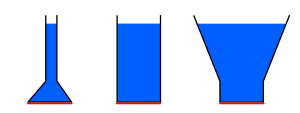Hydrostatic paradox facts for kids
Imagine diving into a swimming pool or even just pouring water into a glass. Have you ever wondered why you feel a push from the water, or why a boat floats? This is all thanks to something called liquid pressure. Liquids, like water, push on everything around them. This pressure is super important and helps us understand how many things work, from how submarines dive to how hydraulic brakes stop a car.
What is Liquid Pressure?
Liquid pressure is the force that a liquid pushes with on a surface. Think of it like this: the deeper you go in water, the more water is above you. This extra weight of water pushes down, making the pressure greater. This is why your ears might pop when you dive deep!
How Pressure Spreads in Liquids
One cool thing about liquids is that they spread pressure out evenly. If you push on one part of a liquid, that push goes in all directions. This idea is called Pascal's Principle. It means that if you squeeze a bottle filled with water, the water pushes outwards equally on all sides of the bottle.
This principle is used in many machines. For example, hydraulic systems in car brakes use a small push on a pedal to create a much bigger push on the brake pads, stopping the car. The image you see shows something called the hydrostatic paradox. It means that the pressure at the bottom of a container depends only on the height of the liquid, not the shape of the container or how much liquid is in it.
What is Buoyancy?
When an object is in a liquid, the liquid pushes on it from all sides. But the push from below is stronger than the push from above. This upward push is called buoyancy. Buoyancy is what makes objects float or feel lighter in water.
- If an object's weight is less than the buoyant force, it will float.
- If an object's weight is more than the buoyant force, it will sink.
This is why a big, heavy ship can float, but a small rock sinks. The ship's shape helps it displace (move aside) a lot of water, creating a large buoyant force.
See also
 In Spanish: Paradoja de Pascal para niños
In Spanish: Paradoja de Pascal para niños


